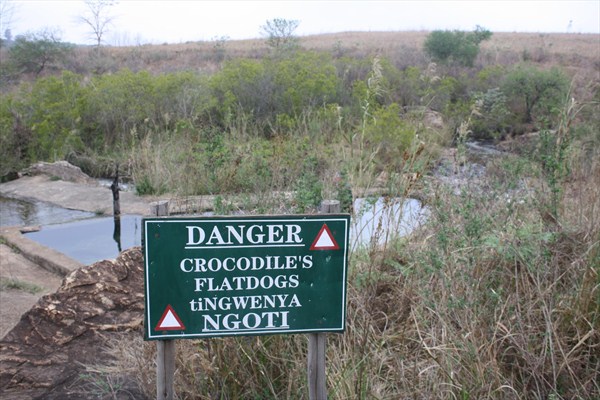The listed waypoint will take you to one of
the hot springs that provides a overall picture of the two parallel
crustal weakness lines beneath Swaziland. This hot spring is
situated in the Mlilwane Nature Reserve.
Mlilwane, meaning “little fire”
was derived from the numerous fires started by lightning strikes on
Mlilwane hills many years ago.
Please be careful at the site, as there
can be crocodiles and Hippo’s
around.

Unique layout of hot springs in Swaziland:
Plotting all the hot springs in Swaziland (see map layout
included below), you will clearly see the two parallel lines they
form, indicating the crustal weakness lines in the archaean basement, that is made up of granite, an
igneous rock which has cooled deep in the earth's crust and has for
most of its history been covered by later rocks, only recently
being stripped of its cover and appearing at the surface. The hot
springs in Swaziland provides the only overall picture of this
crustal weakness and direction of the parallel lines that is about
13 degrees north-south direction.

What is a “hot spring” or
“thermal spring”:
A hot spring is a spring that is produced by the emergence of
geothermal-heated groundwater from the earth's crust. The source of
this heat is the centre of the earth with a
temperature of about 4200°C. Most of it has been generated by the
decay of radio-active isotopes and flow along a geothermal gradient
from the centre of the earth to the surface. Heated
water from the core of the earth becomes less dense and is forced
to the surface through permeable fracture zones and related
phenomena.
Swaziland has numerous thermal springs, mainly small and many
discharge water of relatively high temperature. Most of the springs
emanate in the Middleveld and Highveld. The thermal springs of Swaziland have been
studied for many years, partly out of academic interest and often
in the evaluation of long-term use as a tourist attraction. In one
instance, the Royal Swazi Sun Hotel, located at
Ezulwini was built around a thermal spring
and operates a spa as a commercial venture.
Hot springs usage:
Hydrothermal systems of this nature are
very stable features, persisting naturally for several hundred
thousand to more than a million years. Hot springs and thermal
pools have been used from the dawn of mankind for swimming,
bathing, and cooking as well as healing the body and soul. These
and related phenomena-geysers, boiling mud pots, and fumaroles (steam-vents) are the surface expressions of
natural hydro-systems, now widely developed for such diverse
applications as electric- power production and road way snow
melting. Modern usage falls naturally into three main categories;
corresponding in general to progressively lower resource
temperature-electric power generation, direct heating, and
geothermal heat pumps.
In Swaziland, like all natural resources on SNL, the thermal springs are used communally for a
myriad of uses such as bathing, washing clothes, therapeutic
bathing and healing of the body and soul, and for ritual
cleansing.
Acknowledgments:
Internet link http://www.bscw.ihe.nl/pub/bscw.cgi/d2607673/Mwendera1.pdf
Robin, N.S. and A.C. Wilson, 1978.
The Thermal Springs of Swaziland; their location
and description.
To get credit for a find on this EarthCache you
need to answer the following questions in a mail to the cache
owner.
- What do you think is the reason for the “bubbles”
that can be seen in the bottom of the pool being released?
- With this location, on which crustal weakness line do you think
this hot spring is generated?
- Estimate the temperature difference of the spring water and the
river next to the spring?
- Is the water in the spring “clear” or
“milky” in colour?
- Estimate the “discharge rate” as seen on the
overflow of the spring wall, in litres per
minute?